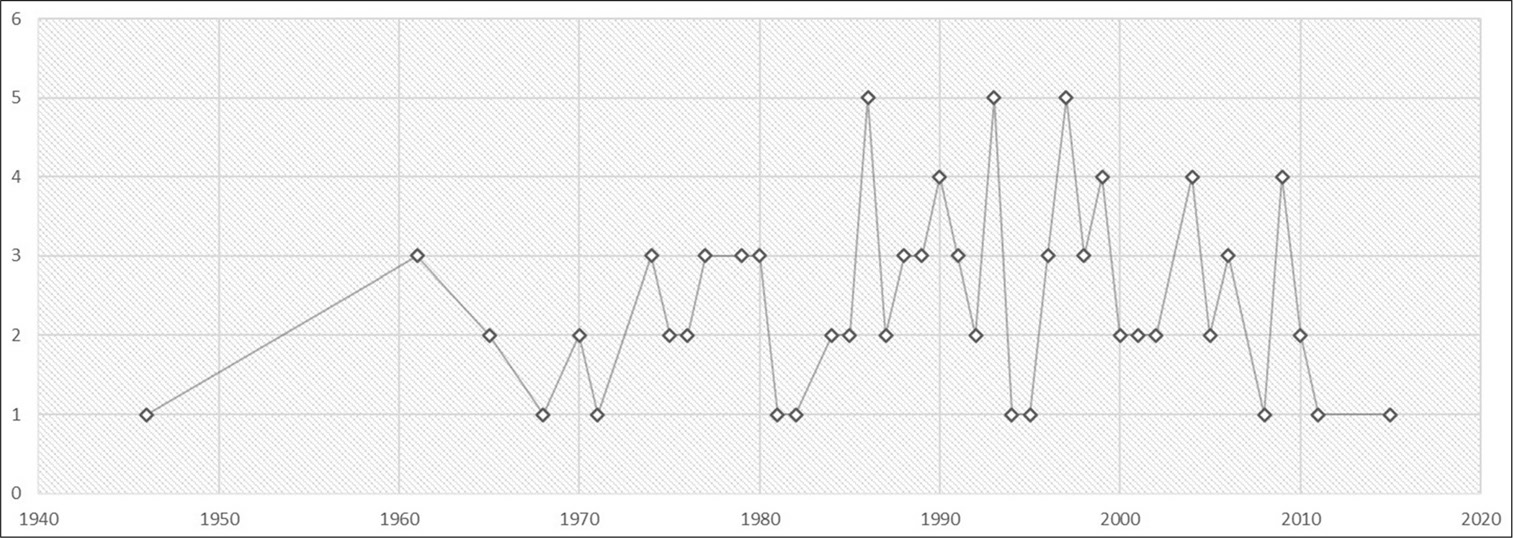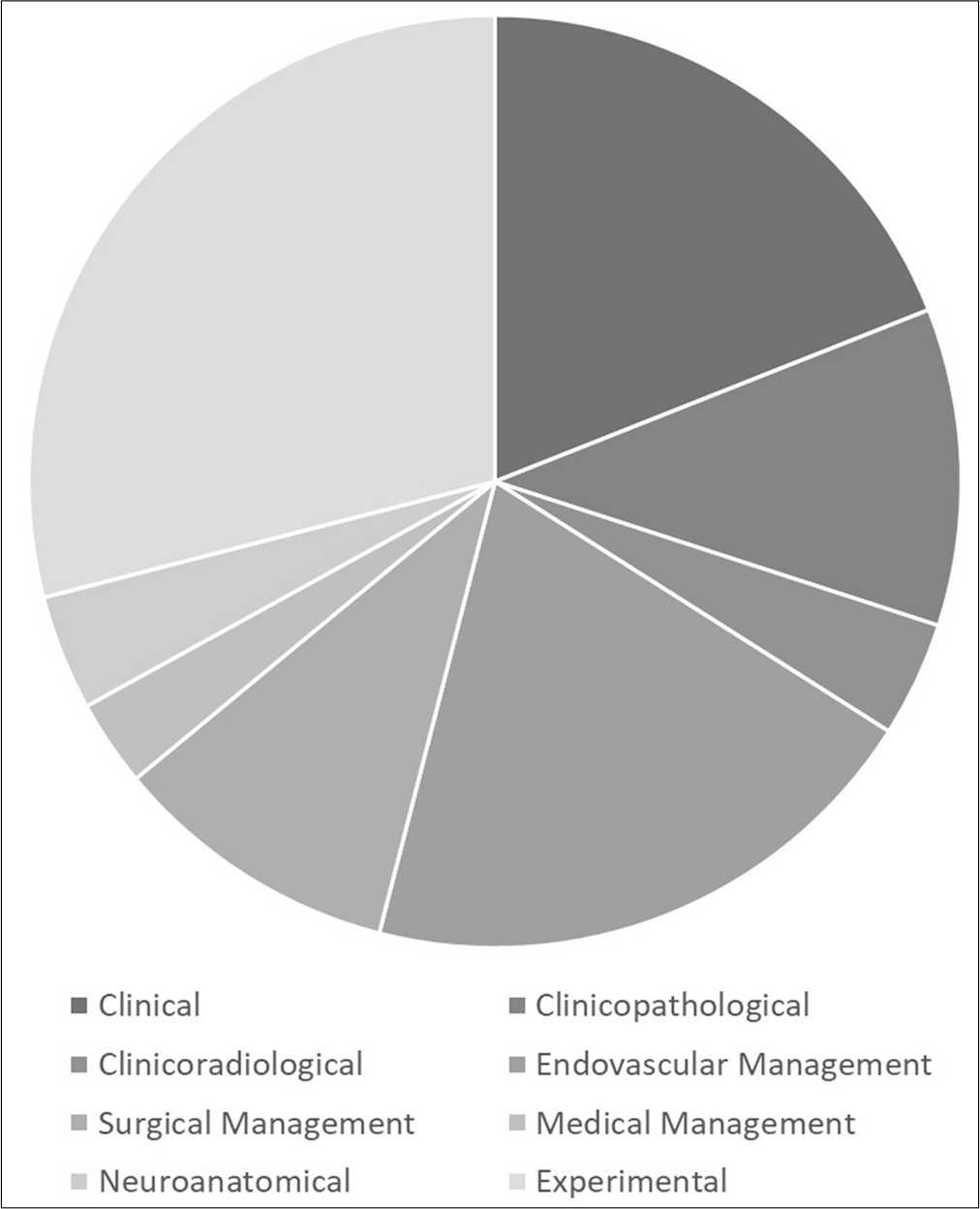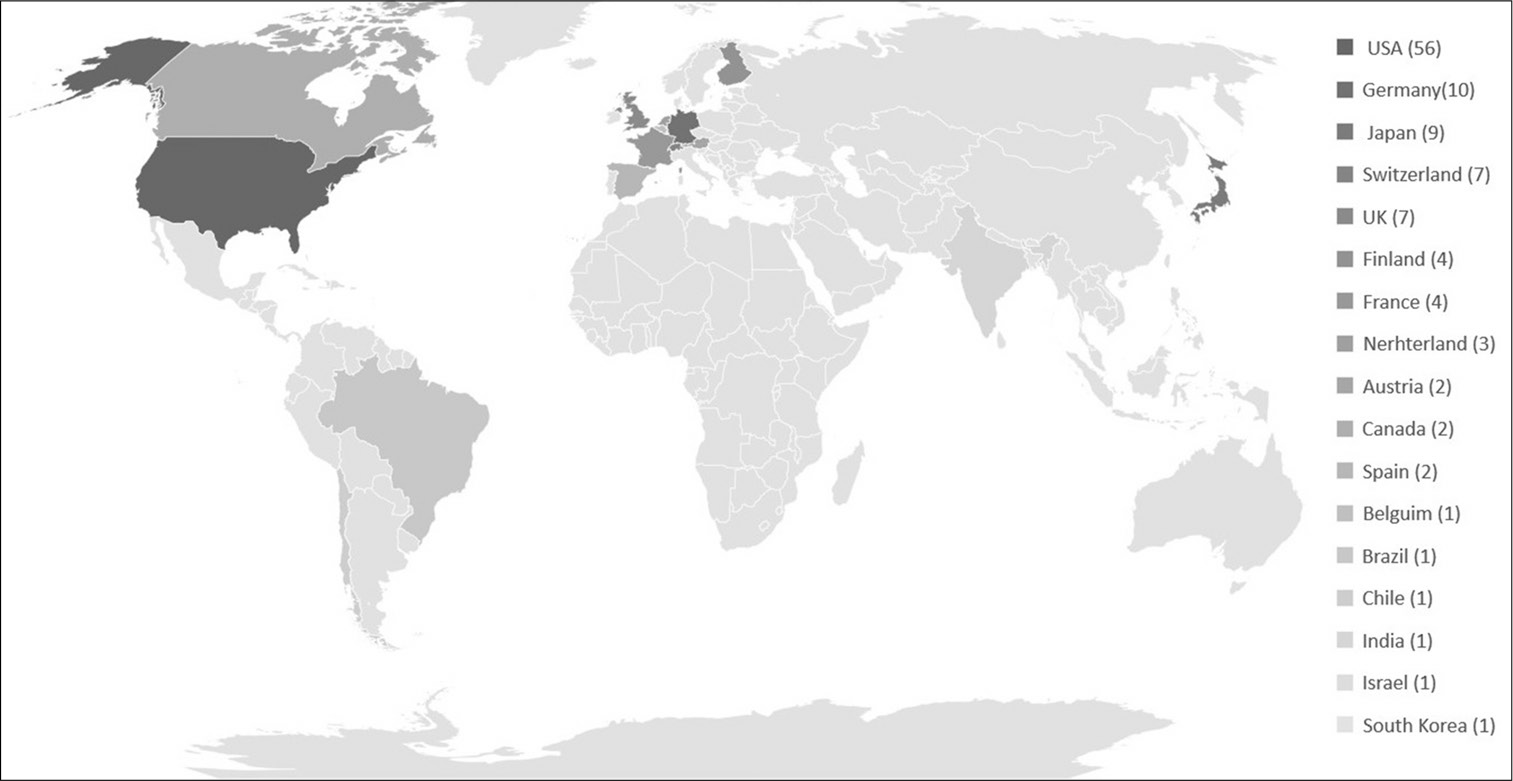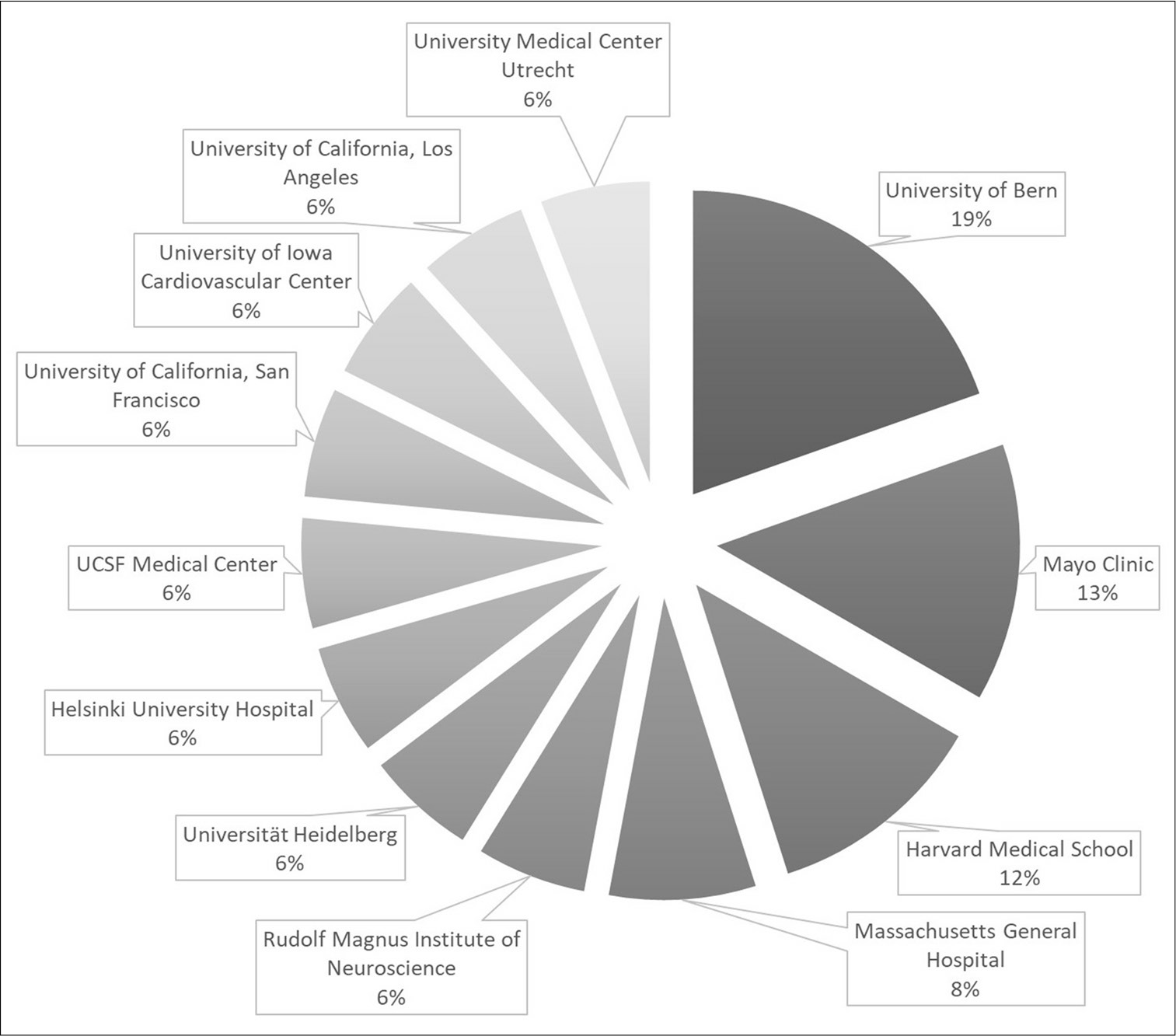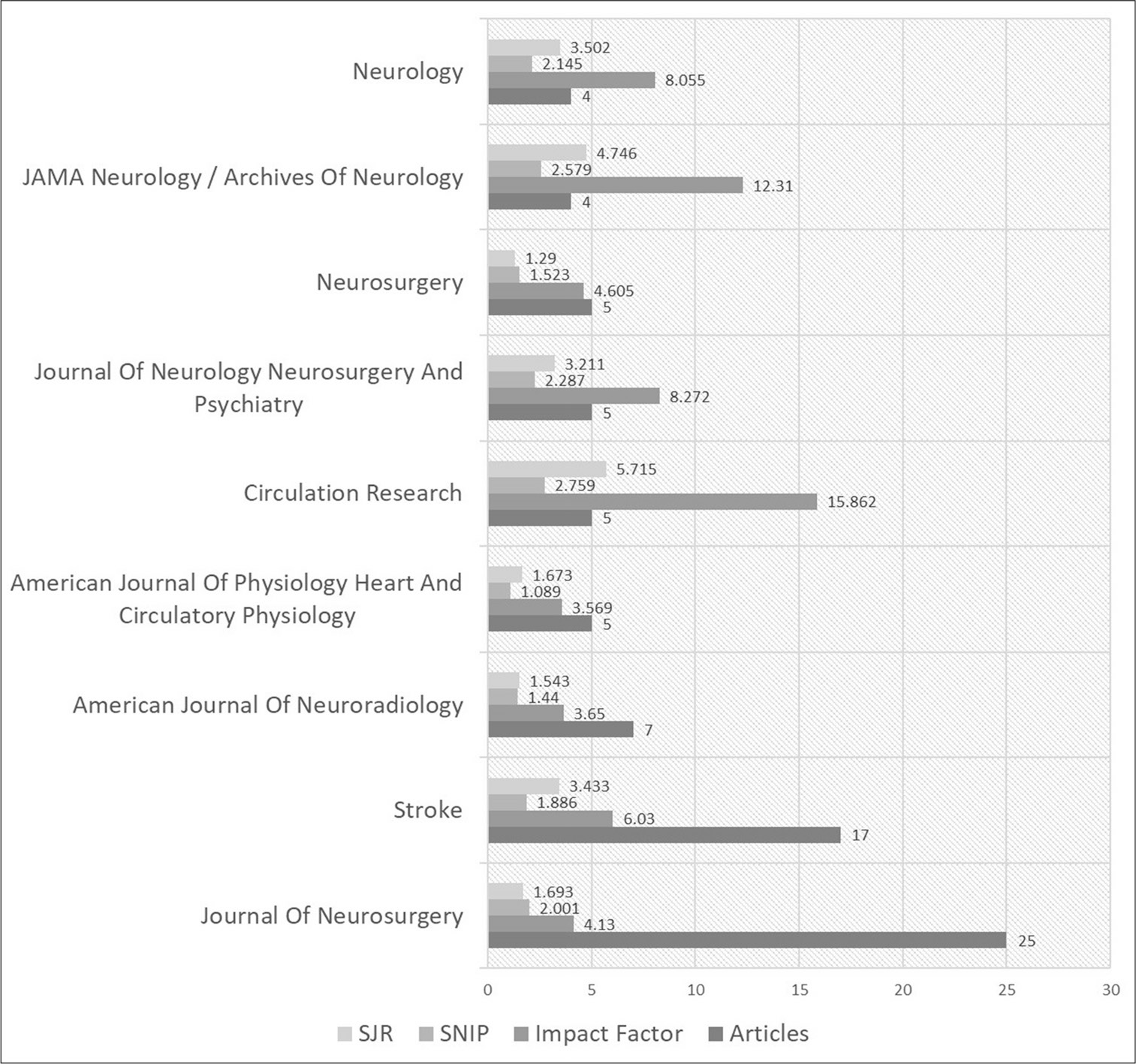- Department of Neurosurgery, University of Miami, Miami, Florida, United States,
- Adult Neurosurgery Department, Neuroscience National Institute, King Fahad Medical City, Riyadh, Kingdom of Saudi Arabia,
- College of medicine, Alfaisal University, Riyadh, Kingdom of Saudi Arabia.
DOI:10.25259/SNI_424_2020
Copyright: © 2020 Surgical Neurology International This is an open-access article distributed under the terms of the Creative Commons Attribution-Non Commercial-Share Alike 4.0 License, which allows others to remix, tweak, and build upon the work non-commercially, as long as the author is credited and the new creations are licensed under the identical terms.How to cite this article: Turki Elarjani1, Othman T. Almutairi2, Modhi A. Alhussinan3, Mohammed Bafaquh2, Abdulrahman Y. Alturki2. Bibliometric analysis of the top 100 most cited articles on the basilar artery. 25-Sep-2020;11:307
How to cite this URL: Turki Elarjani1, Othman T. Almutairi2, Modhi A. Alhussinan3, Mohammed Bafaquh2, Abdulrahman Y. Alturki2. Bibliometric analysis of the top 100 most cited articles on the basilar artery. 25-Sep-2020;11:307. Available from: https://surgicalneurologyint.com/surgicalint-articles/10286/
Abstract
Background: The basilar artery (BA) is one of the most critical vessels that supply blood to the brain stem, cerebellum, and parts of the cerebral hemispheres. Many studies on the BA from neurobiological, clinical, and experimental perspectives exist. This bibliometric study was aimed at identifying the most-cited articles related to the BA in different disciplines.
Methods: A title-specific search was carried out using the Scopus database, and the top 100 most-cited articles were collected and analyzed. Article- and cytometric-based parameters were established for the literature review.
Results: The top 100 articles have an accumulative citation count of 13,595, with an average of 135.95 citations per paper. The publication dates range from 1946 to 2015, with the most productive years being those in the 1990s. Experimental studies are the most frequent category, followed by endovascular ones. The top-cited article has received a total of 435 citations, with 18.12 citations per year. The United States of America has contributed the most to the top 100 cited articles. The lead research institution was the University of Bern, and the most contributing journal was the Journal of Neurosurgery.
Conclusion: A bibliometric analysis of BA researches revealed landmark papers and trends over the years, such as on the introduction of endovascular management in basilar aneurysm and occlusion. The highly cited articles in multi-disciplinary areas related to the BA may help develop future novel ideas for research in the laboratory and translational fields.
Keywords: Basilar artery aneurysm, Basilar artery, Bibliometric, Citation analysis
INTRODUCTION
The basilar artery (BA) is formed by the joining of two vertebral arteries at the pontomedullary junction. It courses close to the brainstem and terminates at the pontomesencephalic sulcus (in almost 80% people). It divides into an inferior branch (superior cerebellar artery) and a superior branch (posterior cerebral artery).[
The BA can be affected by various disease processes, such as BA occlusion (1% of ischemic stroke) due to thrombus formation from atheromas (26–36%) or thrombus embolism (30–35%).[
Bibliometric analysis is a citation-based assessment of the significance and impact of individual articles in their respective fields. It is considered a new research method and was officially defined and introduced in 1969.[
MATERIALS AND METHODS
The Scopus database was used to perform a title-specific search with no time restriction in June 2020, aiming to identify the most impactful articles published on BA “Basilar artery” was used as the keyword for the search to define the most-cited works on the same. The top 100 most-cited articles were selected for further analysis. Pertinent bibliometric parameters were obtained for analysis. The factors included the following: article-based parameters (Title, CC, C.Y., year of publication, and country of publication); journal-based parameters (publishing journal, SNIP, SJR, IF); and an author-based parameter (H-index, the specialty of the 1st author).
A comprehensive review of the most-cited articles was performed to classify them. The top 100 articles yielded were classified into the following eight categories: (1) clinical, (2) clinicopathological, (3) clinicoradiological, (4) endovascular management, (5) surgical management, (6) medical management, (7) neuroanatomical, and (8) experimental.
RESULTS
The data search included 3354 articles published between 1833 and 2020. The top 100 highly cited articles were published between 1946 and 2015, with a total of 13,595 citations and an average of 135.95 citations per article, in which the rate of self-citation for all authors accounted for 7.84% in the list [
The United States of America was the country that contributed the most to the cited articles [
In Stroke, Brandt et al. (1996) published the most-cited article on the BA, titled “Thrombolytic therapy of acute BA occlusion: variables affecting recanalization and outcome.” It received a total of 435 citations at 18.12 citations/year.
DISCUSSION
Initial studies of the top 100 cited articles on BA were diverse and mostly in the clinical category, with a significant focus on defining different disease patterns. BA thrombosis and migraine were popular in the 1900s–1960s. In the 1960s–1970s, authors were interested in studying the detailed surgical anatomy of the cerebral circulation, including BA. The natural history of BA aneurysm was dismal and with no active intervention until the 1960s, which was when renowned neurosurgeons attempted the first surgical management; similar publications surged in the 1970s on the different surgical techniques used in managing BA aneurysms. Experimental studies on cerebral vasospasm in animals were popular in the 1970s. In the 1980s, experimental studies on cerebral vasospasm in animals exponentially increased. The utilization of computed tomography (CT) to study the anatomy of BA and its different pathologies was also popular. Besides, endovascular techniques were of paramount interest for their utility in managing BA aneurysms and occlusion.
More publications using endovascular techniques were witnessed in the 1990s. Clinicians tried different endovascular modalities in managing BA aneurysms and thrombosis, such as coiling, stent-assisted coiling, or intravascular thrombolysis. Animal experiments on the molecular pathways of vasospasm continued with advancements in laboratory techniques. Studies comparing the efficacy and outcome of microsurgical and endovascular modalities in BA aneurysms management were published. Since the beginning of the 21st century, most of the publications have been on the endovascular management of BA aneurysms and thrombosis, and the pattern is rapidly evolving with newer techniques and devices.
The article with the highest number of citations overall (in both the medical and endovascular categories), that is, 435 CC and 18.12 CY, is “Thrombolytic therapy of acute BA occlusion: variables affecting recanalization and outcome” by Brandt et al. (1996) in Stroke. The study concluded that multiple important factors dictate the outcome of BA occlusion by a thrombus embolism or an atheroma. Patients who received intra-arterial or venous thrombolysis had a mortality rate of 46%, while the nonthrombolytic group had a 92% mortality rate (P < 0.0004). In addition, variables that affect mortality are the location of occlusion (P < 0.0011), patient’s age (P < 0.0008), and collateral circulation status (P < 0.04).[
Experimental category
The experimental category (peak publications in 1990– 1997) had the highest publication number of all the categories. Studies performed on animal subjects in the 1970s and 1980s tested the vasospastic activities of BA in induced subarachnoid hemorrhage or the administration of vasoactive materials, such as serotonin and phenylephrine. Over the next years, researchers studied the intracellular pathways of vasospasm using BA and other intracranial vessels. Further, authors tested the various factors that may play a role in vasospasm, such as lipid hydroperoxides. Some authors researched the blood flow turbulence in vessels with aneurysms. The highest-cited article in the category (ranked 14th overall), with 204 CC and 5.66 CY, is “Vasopressin causes endothelium-dependent relaxations of the canine basilar artery” by Katusic et al. (1984) in Circulation Research. The experiments showed that endothelium mediates vascular relaxation induced by vasopressin; the absence of endothelium negates the vascular dilation activity of vasopressin.[
Endovascular category
The endovascular management category (peak publications in 1993–1999) contains one of the highest cited articles due to the revolutionary changes it brought with different, minimally invasive management of vascular pathologies. Initial papers help shed light on the possibility of managing BA occlusion with intra-arterial or venous thrombolysis. Simultaneously, other studies have demonstrated the efficacy of mechanical thrombectomy. Multiple articles published in the 1990s show the utility of stenting in BA stenosis. In addition, aneurysm research was possible due to evolutions in the different endovascular devices used for management, such as stent-assisted coiling. Afterward, flow diverters were introduced as a new modality to manage aneurysms. Some papers have compared the outcome of endovascular and surgical management of BA aneurysms.
The third highest cited article in the endovascular category (ranked 4th overall), with 330 CC and 23.57 CY, is “Therapy of BA occlusion: a systematic analysis comparing intra-arterial and intravenous thrombolysis” by Lindsberg and Mattle (2006) in Stroke. The authors found no difference between the outcomes of intravenous and intra-arterial thrombolysis; however, recanalization rates were higher in intra-arterial than in intravenous thrombolysis (P < 0.05).[
Clinical category
The clinical category (peak publications in 2002–2015) was mainly focused on the study of BA occlusion and stenosis from the 1960s to the 2010s. Most authors examined the natural history, outcome, and clinical presentation of BA occlusion and BA migraine. Different treatment modalities and their complications were described for BA occlusion over the following years. The highest cited article in the clinical category (ranking 3rd overall), with 345 CC and the highest overall in terms of C.Y. (31.36), is “Treatment and outcomes of acute BA occlusion in the BA International Cooperation Study (BASICS): a prospective registry study” by Schonewille et al. (2009) in The Lancet Neurology. This study divides patients who have BA occlusion into three groups: antithrombotic treatment group, intravenous or intra-arterial thrombolysis group, or intra-arterial therapy (mechanical thrombectomy). In patients with mild-to-moderate clinical presentation, there was no difference in the outcomes of the three groups; patients with severe presentations were found to have an unfavorable prognosis in the antithrombotic treatment group as compared to intravenous/arterial thrombolysis or intra-arterial therapy. However, there was no difference between intravenous/arterial thrombolysis and intra-arterial therapy in the severe presentation group.[
Clinicopathologic category
The clinicopathologic category (peak publications in 1984–1987) focused on defining the clinical presentation and pathophysiology of BA occlusion, aneurysm, and dolichoectasia. The highest cited article in the category (ranked 6th overall), with 269 CC and 3.53 CY, is “Occlusion of the basilar artery – a clinical and pathological study” by Kubik and Adams (1946) in Brain. The authors examined 18 autopsies for BA occlusion and studied the mechanism of occlusion through thrombus embolism or atheroma-induced thrombosis, considering the symptomatology of this disease.[
Surgical category
The surgical management category had a bimodal peak publication in 1961–1968 and 1980–1988. In the 1960s, the technical notes of successful BA aneurysms clippings were surging, followed by alternative surgical approaches to aneurysms along the entire length of the BA. In the 1980s, some authors published papers on the utility of hypothermia, circulatory arrest, and barbiturate coma in surgically managing complex BA aneurysms. The highest cited article in the category (ranked 5th overall), with 290 CC and 8.28 CY, is “Transpetrosal approach for aneurysms of the lower basilar artery” by Kawase et al. (1985) in the Journal of Neurosurgery. The authors demonstrated that the extradural subtemporal approach and drilling of the anterior pyramidal bone yield a large operative corridor for proximal BA aneurysms, sparing the temporal lobe and cranial nerves and avoiding brainstem retraction injury.[
Neuroanatomy category
The neuroanatomy category publications peaked in 1976– 1977. Initially, the authors studied the surgical anatomy of the posterior circulation, including the different variations of the BA’s orientation, route, and branches. Further, the BA average caliber and variations were studied in addition to the essential perforators to the brainstem and thalamus. Later, articles were focused on the BA radio-anatomical correlation using CT scans and cadaveric specimens. The highest cited article in the category (ranked 9th overall), with 245 CC and 5.9 CY, is “Microsurgical anatomy of the upper basilar artery and the posterior circle of Willis” by Saeki and Rhoton Jr. (1977) in the Journal of Neurosurgery. The authors have described the detailed anatomy of the upper segment of the posterior circulation to the posterior cerebral arteries. The largest segment, branch, number of perforators in each segment, and incidence of different variations and hypoplastic vessels have been described.[
Clinicoradiological category
The clinicoradiological category (peak publications in 2005– 2010) mainly consists of BA occlusion studies. Initial studies researched the radiological appearance of BA occlusion. In the 21st century, studies focused on high-resolution magnetic resonance imaging (MRI) to identify intra-luminal atheromas; concurrently, other studies used CT angiogram to predict functional outcome in patients with BA occlusion. The highest cited article in the category (ranked 12th overall), with 228 CC and 5.8 CY, is “Basilar artery occlusion: clinical and radiological correlation” by Archer and Horenstein (1977) in Stroke. The authors concluded that the extent of BA occlusion and low level of consciousness at presentation are poor prognostic factors.[
Medical management category
The medical management category (peak publications in 2004–2005) was focused on the use of antiplatelet or anticoagulation for the management of BA occlusion. Later, the authors compared observation-only management and the use of anti-platelets or anticoagulation for BA occlusion. The second highest cited article (ranked 27th overall), with 152 CC and 9.5 CY, is “Long-term outcome after intravenous thrombolysis of basilar artery occlusion” by Lindsberg et al. (2004) in The Journal of the American Medical Association. Patients who received intravenous thrombolysis were followed at 3 months and 1 year for functional outcome and survival. At 3 months, the recanalization rate was 52%, and mortality was 40%; 24% were functionally independent, while 16% had a severe functional disability. At 1 year, 30% reached functional independence, and 46% died.[
Limitations
Since the emergence of bibliometric reviews, many inherent limitations have been identified. The citation accumulation over time was found to be biased toward old articles, but the consideration of citations per year minimizes this predilection. The usage of citation count as a representative of the article’s influence is not optimal for the following reasons: the number of citations does not reflect the value of the articles in a particular field, wherein peer-reviewed articles must be used with bibliometrics to complement the representation of field changing or impactful articles.[
Database-specific limitations in the Scopus search engine limit the full citation coverage dates in 1970–2020, and the citation count for articles published before this period may be underrepresented. Examination of the authors’ self-citations as an inherent limitation of bibliometrics demonstrated a negligible effect in our study, at a rate of 7.4% for the total number of citations. Last, a publication in a highly impactful journal, based on their scientometric parameters, does not guarantee that all the publications in this journal are highly impactful in the studied field.[
CONCLUSION
The top-cited BA publications initially revolved around studying the natural history and management of BA occlusion, followed by the surgical anatomy of posterior circulation vessels. Subsequent articles focused on the surgical management of aneurysms and endovascular treatment of aneurysms as well as BA occlusion. Bibliometric analyses constitute a contemporary method of reviewing, analyzing, and summarizing highly cited articles. Most notably, top articles are cited for their impact in their respective fields and their evidence-based approach. We reviewed and analyzed the top 100 studies in BA to provide an introductory article on BA multi-disciplinary publications for junior clinicians within related medical specialties. In addition, the publication trend may pave the way for novel research ideas in the future.
Declaration of patient consent
Patient’s consent not required as patients identity is not disclosed or compromised.
Financial support and sponsorship
Nil.
Conflicts of interest
There are no conflicts of interest.
References
1. Alfaifi A, AlMutairi O, Allhaidan M, Alsaleh S, Ajlan A. The top 50 most-cited articles on acoustic neuroma. World Neurosurg. 2018. 111: e454-64
2. Almutairi O, Albakr A, Al-Habib A, Ajlan A. The top-100 most-cited articles on meningioma. World Neurosurg. 2017. 107: 1025-32
3. Archer CR, Horenstein S. Basilar artery occlusion: Clinical and radiological correlation. Stroke. 1977. 8: 383-90
4. Atci IB, Yilmaz H, Samanci MY. The top 50 most-cited articles on low-grade glioma: A bibliometric analysis. Br J Neurosurg. 2019. 33: 171-5
5. Belter CW. Bibliometric indicators: Opportunities and limits. J Med Libr Assoc. 2015. 103: 219-21
6. Brandt T, von Kummer R, Müller-Küppers M, Hacke W. Thrombolytic therapy of acute basilar artery occlusion. Variables affecting recanalization and outcome. Stroke. 1996. 27: 875-81
7. Dinc N, Quick-Weller J, Tritt S, Konczalla J, Mersmann J, Bruder M. Vasospasm of the basilar artery following spontaneous SAH-clinical observations and implications for vascular research. Neurosurg Rev. 2019. 42: 983-9
8. Ellegaard O, Wallin JA. The bibliometric analysis of scholarly production: How great is the impact?. Scientometrics. 2015. 105: 1809-31
9. Henkes H, Fischer S, Weber W, Miloslavski E, Felber S, Brew S. Endovascular coil occlusion of 1811 intracranial aneurysms: Early angiographic and clinical results. Neurosurgery. 2004. 54: 268-80
10. Higashida RT, Smith W, Gress D, Urwin R, Dowd CF, Balousek PA. Intravascular stent and endovascular coil placement for a ruptured fusiform aneurysm of the basilar artery. J Neurosurg. 1997. 87: 944-9
11. Katusic ZS, Shepherd JT, Vanhoutte PM. Vasopressin causes endothelium-dependent relaxations of the canine basilar artery. Circ Res. 1984. 55: 575-9
12. Kawase T, Toya S, Shiobara R, Mine T. Transpetrosal approach for aneurysms of the lower basilar artery. J Neurosurg. 1985. 63: 857-61
13. Kubik CS, Adams RD. Occlusion of the basilar artery; a clinical and pathological study. Brain. 1946. 69: 73-121
14. Lindsberg PJ, Mattle HP. Therapy of basilar artery occlusion: A systematic analysis comparing intra-arterial and intravenous thrombolysis. Stroke. 2006. 37: 922-8
15. Lindsberg PJ, Soinne L, Tatlisumak T, Roine RO, Kallela M, Häppölä O. Long-term outcome after intravenous thrombolysis of basilar artery occlusion. JAMA. 2004. 292: 1862-6
16. Luukkonen T. Bibliometrics and evaluation of research performance. Ann Med. 1990. 22: 145-50
17. Marlin ES, Ikeda DS, Shaw A, Powers CJ, Sauvageau E. Endovascular treatment of basilar aneurysms. Neurosurg Clin N Am. 2014. 25: 485-95
18. Mattle HP, Arnold M, Lindsberg PJ, Schonewille WJ, Schroth G. Basilar artery occlusion. Lancet Neurol. 2011. 10: 1002-14
19. Pritchard A. Statistical bibliography or bibliometrics?. J Doc. 1969. 25: 348-9
20. Saeki N, Rhoton AL Jr. Microsurgical anatomy of the upper basilar artery and the posterior circle of Willis. J Neurosurg. 1977. 46: 563-78
21. Schonewille WJ, Wijman CA, Michel P, Rueckert CM, Weimar C, Mattle HP. Treatment and outcomes of acute basilar artery occlusion in the basilar artery international cooperation study (BASICS): A prospective registry study. Lancet Neurol. 2009. 8: 724-30
22. Torche M, Mahmood A, Araujo R, Dujovny M, Dragovic L, Ausman JI. Microsurgical anatomy of the lower basilar artery. Neurol Res. 1992. 14: 259-62



